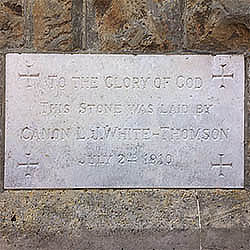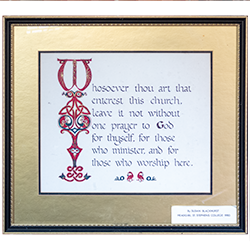MENU
St Andrew's, Reading Street
One family with Christ at the centre, welcoming all!
A Brief History of St Andrew's
The history of the church in Reading Street dates back to 1868 with the building of the Church Infant School (a building which is now a private house but the bell is in St Andrew's Church). When Canon Whitehead became Vicar of St Peter's in 1871, a curate was sent down to take Divine Service in the school and in time it was felt that the village should have its own church. A first step was taken when the church hall was built and dedicated by the Rt Rev William Walsh, Bishop of Dover in 1907. It was used as a dual purpose building before adjacent land was used to build the church. Since then the hall has been used as a meeting place for many clubs and societies, and following a major re-building project in 1999, continues to be used for this, but in considerably more comfort.
Shortly after the church hall was completed it was decided to build a new church and the foundation stone was laid by Canon L J White-Thompson on 2nd July 1910. Canon White-Thompson was Vicar of Croydon at the time but had been the vicar at St Peter-in-Thanet until 1909. It was decided to dedicate the new church to St Andrew the Apostle. The church was consecrated by the Lord Archbishop of Canterbury, Dr Randall Davidson on 11th April, 1911 and immediately, those responsible took it in hand to begin the completion of the interior furnishings, as well as to develop the spiritual life of the Church. However, this was sadly curtailed by the outbreak of World War 1, when the church had to be closed, owing to the absence of clergy, who were serving in the Armed Forces. But immediately after the cessation of fighting, the church was re‑opened for worship. In 1920, a beautiful oaken screen, dividing the chancel and nave, commemorating the villagers who did not return from the war, was dedicated. The panels on each side list the fallen from the village (20 men) and those from Rimpton School (14 ex‑pupils and one former master).
The necessity of a good organ was met by the raising of £400, enabling Mr R J Brown to build the present instrument, which is still in use today. Any attempt to describe St Andrew's Church must include appreciation of the very beautifully timbered roof of the nave and sanctuary. It is excellently matured, and comparable in workmanship to the hammer-beamed roofs we see in many English Churches built in the middle ages. This fits in suitably with the attractive red brick interior, in English bond; the exterior being flanked with local Kentish ragstone. With its graceful bell tower and spire, nestling snugly with the roofs of other buildings in the village, St Andrew's has, since 1911, been an integral presence in this community and still enjoys the respect and affection of those it is called to serve.
More recently (in 2011, its centenary year) St Andrew's became a parish in its own right, breaking its parent-daughter relationship with St Peter's and becoming part of the Broadstairs Group Ministry with St Peter‑in‑Thanet and Holy Trinity, Broadstairs.

